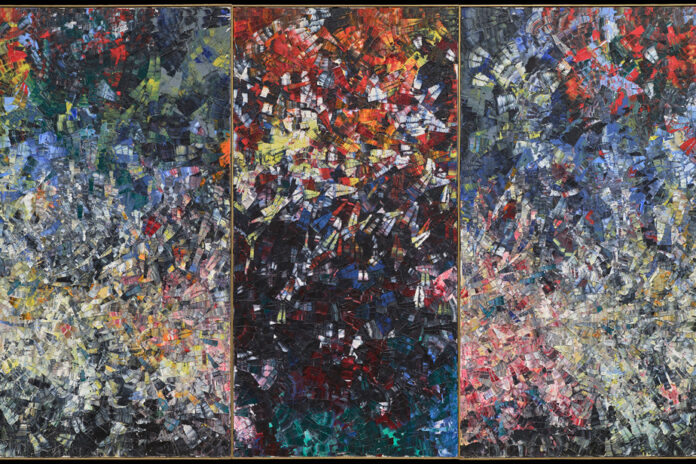(Montreal) The year 2023 marks the hundredth anniversary of the birth of painter Jean-Paul Riopelle. To mark this milestone year, several events celebrating the artistic freedom and creativity of the world-renowned artist are dedicated to him across the country.
Born on rue de Lorimier in Montreal on October 7, 1923, Jean-Paul Riopelle was a painter, engraver and sculptor whose career spanned more than six decades, in Quebec and France. A pupil of Paul-Émile Borduas, Riopelle joined the group Les Automatistes and in 1948 became a signatory of Refus global. He died on March 12, 2002 and remains, to this day, one of the most influential Canadian artists on the planet.
Established in 2019 by Canadian philanthropists, collectors and art lovers, the Jean-Paul Riopelle Foundation, which the artist himself had dreamed of in the 1960s, oversees the centennial festivities which are intended to be “the most important celebration, the most important tribute ever paid to a Canadian artist”, according to its Executive Director, Manon Gauthier.
This colossal duty of remembrance began a year before the anniversary date, October 7, 2022, with the unveiling of Marc Séguin’s new mural on a side wall at 625 Milton Street in Montreal.
Since then and for the next two years, a plethora of events and activities — exhibitions, symphony concert, cinema, educational programs, theater, poetry evening, special programs and even circus — will be held to highlight the many talents of the multidisciplinary artist. .
“There is a very universal side to the work of Jean-Paul Riopelle, underlines Ms. Gauthier, who also acts as general commissioner of the centennial celebrations. Whether we know him or not, we will have the opportunity to discover different facets of his work and his inspirations. »
These were many. “Nature, environment, admiration and celebration of indigenous cultures, migrations, whether of animal species or those he experienced in his life, all these themes that inspired Riopelle’s work are still of great importance. topicality”, underlines the director.
The Jean-Paul Riopelle Foundation has published the entire program of the festivities on its website. Across the country, note the Studio Riopelle educational project and the Dialogues project, where Canadian artists pay tribute to Jean-Paul Riopelle in their own way, in nine provinces and territories.
Riopelle will also be celebrated this summer in France, in Saint-Paul-de-Vence where he resided, as part of an exhibition entitled Parfums d’ateliers and where his daughter Yseut will be guest curator. A tribute exhibition is also planned in Paris at the end of the year.
The celebrations will end with the inauguration, in 2025, of a new pavilion dedicated to the work of Riopelle at the Musée national des beaux-arts du Québec, where we will find works never presented to the public and which were donated by the private collectors.
Riopelle’s centenary will be celebrated, among other things, at the Biosphere-Space for Life in Montreal, with the immersive exhibition Riopelle, a bird in freedom, where visitors will be invited, starting on Saturday, June 3, to explore a universe interactive taking up the decor of L’Isle-aux-Grues and its flights of white geese, a subject that greatly inspired the artist in the last stage of his career.
“The common thread [between the Biosphere and Riopelle] is nature, the love of nature and the flight of geese; it’s the connection we made,” explains the director of the Montreal Biosphere-Space for Life, Isabelle St-Germain.
What’s more, the Biosphere is located on Île Sainte-Hélène, which is “at the heart of a migratory river corridor for several species of birds, including the Canada goose”. Some 300 kilometers away, downstream on the river, we find Île aux Oies, where Riopelle immortalized the migratory birds that fascinated him so much, recalls the director.
“It’s a way for us to talk about the environment by being inspired by the place we are in,” she adds.
In addition to an area where projections of landscapes of Isle-aux-Grues and its famous geese will be accompanied by pieces from the Orchester symphonique de Montréal composed for the occasion, visitors will be able to explore a setting inspired by the Jean-Paul Riopelle’s studio, where they will be invited to take part in a collective creation in the style of the artist.
This three-part exhibition will culminate with the possibility of contemplating an unpublished work by the artist and certain objects that belonged to him, courtesy of Huguette Vachon, Riopelle’s last companion who was at his side for fifteen years. Other works will also be presented in digital format, says Ms. St-Germain.
Around the Biosphere, there is another exhibition, once again based on the work of Riopelle, entitled Migrations. “It is the result of a competition where 12 young artists from the international Francophonie were inspired by the artist’s love for the theme of migration,” explains Isabelle St-Germain. They had to reflect on how climate change influences migratory movements and observe the impact on the fragile balance of migration. »
Everything was made possible thanks to a collaboration with the Jean-Paul Riopelle Foundation, the International Youth Offices of Quebec and the Center de la Francophonie des Amériques.
In October, the National Gallery of Canada will also pay tribute to the multidisciplinary Quebec artist by dedicating to him the Riopelle exhibition, at the crossroads of time, which will cover the period from 1942 to 1992, both in painting and in sculpture, drawing and collage. Unpublished works, never presented to the public, will be loaned by private collectors for the event.
In the meantime, and for several days in the second half of June, visitors will be able to see Marie Catherine Cyr, the Museum’s assistant restorer of paintings, carry out maintenance on one of the artist’s key works, Hommage aux Nymphéas- Pavane.
This painting earned Jean-Paul Riopelle, who represented Canada at the 31st Venice Biennale in 1962, the UNESCO prize. The museum had acquired the work the following year and it has remained there ever since.















